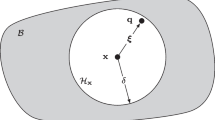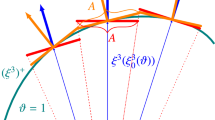Abstract
This paper presents a new numerical integration technique for 3D contact finite element implementations, focusing on a remedy for the inaccurate integration due to discontinuities at the boundary of contact surfaces. The method is based on the adaptive refinement of the integration domain along the boundary of the contact surface, and is accordingly denoted RBQ for refined boundary quadrature. It can be used for common element types of any order, e.g. Lagrange, NURBS, or T-Spline elements. In terms of both computational speed and accuracy, RBQ exhibits great advantages over a naive increase of the number of quadrature points. Also, the RBQ method is shown to remain accurate for large deformations. Furthermore, since the sharp boundary of the contact surface is determined, it can be used for various purposes like the accurate post-processing of the contact pressure. Several examples are presented to illustrate the new technique.
















Similar content being viewed by others
Notes
In this paper, the phrase ‘contact boundary’ is used to refer to the boundary of the contact surface and not to the contact surface itself, as is often done elsewhere since it is part of the boundary of the contacting bodies.
2D surface manifold
The hunting grid can be further improved for efficiency by an adaptive schemes e.g. with the quad tree structure.
Although the convergence here is measured in the energy norm, other measures can also be considered.
Later, RBQ segments can be used for an effective re-meshing around the contact boundary.
This is due to the fact that the two-half-pass algorithm does not enforce the contact traction continuity explicitly for the discretized system, but rather recovers it in the continuum limit, i.e. as the mesh is refined.
References
Agoston MK (2005) Computer graphics and geometric modeling: implementation and algorithms. Springer, London
Borden MJ, Scott MA, Evans JA, Hughes TJR (2011) Isogeometric finite element data structures based on bezier extraction of NURBS. Int J Numer Methods Eng 87:15–47
Bussetta P, Marceau D, Ponthot J-P (2012) The adapted augmented lagrangian method: a new method for the resolution of the mechanical frictional contact problem. Comput Mech 49:259–275
Cichosz T, Bischoff M (2011) Consistent treatment of boundaries with mortar contact formulations using dual lagrange multipliers. Comput Methods Appl Mech Eng 200:1317–1332
Corbett CJ, Sauer RA (2014) NURBS-enriched contact finite elements. Comput Methods Appl Mech Eng 275:55–75
De Lorenzis L, Temizer I, Wriggers P, Zavarise G (2011) A large deformation frictional contact formulation using nurbs-based isogeometric analysis. Int J Numer Methods Eng 87:1278–1300
De Lorenzis L, Wriggers P, Zavarise G (2012) A mortar formulation for 3D large deformation contact using NURBS-based isogeometric analysis and the augmented lagrangian method. Comput Mech 49:1–20
Dimitri R, De Lorenzis L, Scott MA, Wriggers P, Taylor RL, Zavarise G (2014) Isogeometric large deformation frictionless contact using t-splines. Comput Methods Appl Mech Eng 269:394–414
Franke D, Düster A, Nübel V, Rank E (2010) A comparison of the h-, p-, hp-, and rp-version of the FEM for the solution of the 2D Hertzian contact problem. Comput Mech 45:513–522
Franke D, Rank E (2011) Computational contact mechanics based on the rp-version of the finite element method. Int J Comput Methods 8:498–512
Hartmann S, Ramm E (2008) A mortar based contact formulation for non-linear dynamics using dual lagrange multipliers. Finite Elem Anal Des 44:245–258
Hughes T, Cottrell J, Bazilevs Y (2005) Isogeometric analysis: CAD, finite elements, NURBS, exact geometry and mesh refinement. Comput Methods Appl Mech Eng 194:4135–4195
Kiefer J (1953) Sequential minimax search for a maximum. Proc Amer Math Soc 4:502–506
Konyukhov A, Schweizerhof K (2009) Incorporation of contact for high-order finite elements in covariant form. Comput Methods Appl Mech Eng 198:1213–1223
Matzen M, Cichosz T, Bischoff M (2013) A point to segment contact formulation for isogeometric, NURBS based finite elements. Comput Methods Appl Mech Eng 255:27–39
Moës N, Dolbow J, Belytschko T (1999) A finite element method for crack growth without remeshing. Int J Numer Methods Eng 46:131–150
Papadopoulos P, Taylor R (1992) A mixed formulation for the finite element solution of contact problems. Comput Methods Appl Mech Eng 94:373–389
Popp A, Seitz MG, Wall W (2013) Improved robustness and consistency of 3D contact algorithms based on a dual mortar approach. Comput Methods Appl Mech Eng 264:67–80
Puso M, Laursen T (2004) A mortar segment-to-segment frictional contact method for large deformations. Comput Methods Appl Mech Eng 193:601–629
Puso M, Laursen T, and Solberg J (2004) A 3D frictional segment-to-segment contact method for large deformations and quadratic elements. In: European Congress on Computational Methods in Applied Sciences and Engineering
Sauer RA (2011) Enriched contact finite elements for stable peeling computations. Int J Numer Methods Eng 87:593–616
Sauer RA (2013) Local finite element enrichment strategies for 2D contact computations and a corresponding post-processing scheme. Comput Mech 52:301–319
Sauer RA (2014a) A contact theory for surface tension driven systems. Math Mech Solids, doi:10.1177/1081286514521230
Sauer RA (2014b) Stabilized finite element formulations for liquid membranes and their application to droplet contact. Int J Numer Methods Fluids 75:519–545
Sauer RA, De Lorenzis L (2013) A computational contact formulation based on surface potentials. Comput Methods Appl Mech Eng 253:369–395
Sauer RA, Duong TX, Corbett CJ (2014) A computational formulation for solid and liquid membranes based on curvilinear coordinates and isogeometric finite elements. Comput Methods Appl Mech Eng 271:48–68
Stadler M, Holzapfel GA (2004) Subdivision schemes for smooth contact surfaces of arbitrary mesh topology in 3D. Int J Numer Methods Eng 60:1161–1195
Temizer I, Wriggers P, Hughes T (2011) Contact treatment in isogeometric analysis with NURBS. Comput Methods Appl Mech Eng 200:1100–1112
Wriggers P (2006) Computational Contact Mechanics, 2nd edn. Wiley, Chichester
Zavarise G, De Lorenzis L (2009) A modified node-to-segment algorithm passing the contact patch test. Int J Numer Methods Eng 79:379–416
Acknowledgments
The authors are grateful to the German Research Foundation (DFG) for supporting this research under Projects SA1822/5-1 and GSC 111. We also thank Callum Corbett for helpful discussions and support.
Author information
Authors and Affiliations
Corresponding author
Rights and permissions
About this article
Cite this article
Duong, T.X., Sauer, R.A. An accurate quadrature technique for the contact boundary in 3D finite element computations. Comput Mech 55, 145–166 (2015). https://doi.org/10.1007/s00466-014-1087-0
Received:
Accepted:
Published:
Issue Date:
DOI: https://doi.org/10.1007/s00466-014-1087-0





